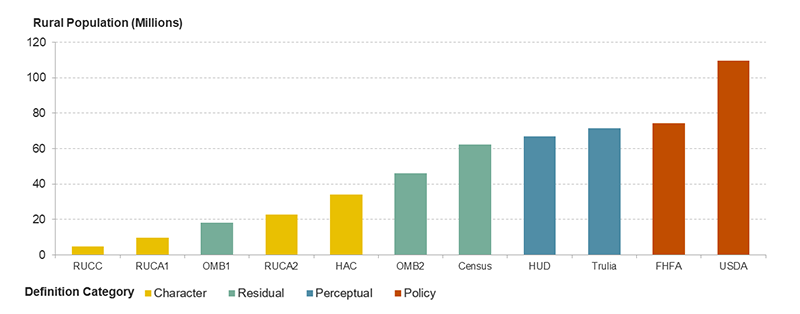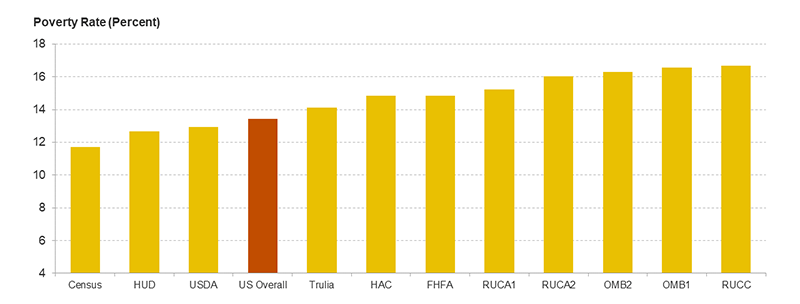How Definitions Shape the Rural Housing Landscape
In the United States, rural areas face significant and unique economic and housing challenges. While far from homogenous, rural areas nevertheless tend to share some similar difficulties that may include a lack of economic activity and diversity, elevated poverty rates, overcrowding, and social isolation, among others. However, making sense of these challenges can be difficult, in part because there is no standard definition of rural used in federal housing policymaking and no consensus definition used in housing research. For example, the US Census Bureau, the Office of Management and Budget (OMB), and the US Department of Agriculture (USDA), among others, all publish different definitions of rural. The result is that important policy and research conversations may be grounded in an understanding of the issues that varies with how rural is defined, potentially complicating or even undermining efforts to address housing needs in these communities.
In a new working paper, “In Search of Rural: How Varying Definitions Shape Housing Research,” we identify and operationalize eleven distinct definitions of rural to see how estimates of the size of the rural housing market, as well as the demographic composition and the nature of its housing challenges, vary depending on the definition chosen. We organize the eleven definitions into four categories based on the definition’s primary purpose. Residual definitions identify urban areas, with the remainder implicitly rural, such as those produced by the Census and OMB. Character definitions center rural experiences and rurality more explicitly by focusing on common features of rural. Perceptual definitions use surveys to characterize places as rural based on how people view the place where they live. Finally, policy definitions set geographic bounds for specific programs that serve rural areas.
We find that the choice of rural definition can matter immensely for the size of the rural housing market and its characteristics. Indeed, depending on the chosen definition, the number of people living in rural areas in 2019 ranges from just 4.7 million to over 109.5 million, or from 1.4 percent to 33.7 percent of the US population (Figure 1). In general, character definitions encompassed the fewest people while policy definitions were the most expansive. Interestingly, many people across the country view their community as rural, and perceptual definitions also produced large rural population estimates. Residual definitions, which are the most frequently used in research, due to data availability, give the widest rural population range.
Figure 1: Policy and Perceptual Definitions Produce the Largest Rural Housing Markets
Like population estimates, descriptions of rural areas’ demographic composition, housing stock characteristics, and housing challenges also vary depending on the definition that is used in the analysis. For example, the homeownership rate ranged from a low of 71.4 percent in non-metro areas under a commonly used residual definition based on the OMB’s metropolitan and micropolitan areas, to a high of 81.6 percent according to the Census definition—a full 10 percentage point difference. Despite these definitional differences, the rural homeownership rate remained above the national homeownership rate of 64.0 percent when using any of the eleven definitions.
Poverty rates in rural areas also ranged widely but produced a less consistent pattern relative to the national rate (Figure 2). Most definitions produced a rural poverty rate higher than the 2019 national rate of 13.4 percent. For example, rural poverty was highest at 16.7 percent when using the Rural-Urban Continuum Codes (RUCC), the most restrictive definition of rural that we used. However, rural poverty rates were lower than the national rate when applying definitions from the Census (11.7 percent), the US Department of Housing and Urban Development (12.7 percent) and USDA (12.9 percent), perhaps challenging the notion that poverty is more prevalent in rural communities.
Figure 2: Depending on the Definition, Poverty Rates Can Be Either Below or Above the Overall US Rate
Of course, there is no perfect or singularly correct definition of rural, particularly given the lack of “good" data available on rural communities. However, as our findings illustrate, choice of definition can substantially impact how researchers and policymakers understand the size of rural markets as well as the areas’ socioeconomic and housing challenges. Depending on the definition, a rural area may be described as having unique challenges that necessitate unique solutions or, alternatively, as communities whose challenges more closely resemble those of their urban or suburban counterparts.
In light of these findings, researchers and policymakers should be thoughtful and intentional when it comes to defining rural, and assess how different definitions may alter their conclusions. This includes considering the project goal and how it will be impacted by a more or less inclusive definition. By doing so, researchers and policymakers can ensure that their work best captures the realities of rural communities.



